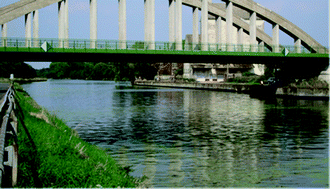Speciation of mercury in the strongly polluted sediments of the Deûle River (France)
Abstract
The Deûle River in Northern France experienced serious contamination from the metallurgical industry, especially from the smelter Metaleurop prior to 2003. In 2002 the surface sediments were collected from the bed of the river around 10 km above and 10 km below the smelter. Total mercury (HgT) and methylmercury (MeHg) concentrations exceeded the background value of 0.1 mg kg−1. The average concentrations were 19.67 ± 1.02 mg kg−1 and 10.88 ± 1.08 μg kg−1, respectively. In 2003 the sediment core samples were collected at two different sites near the factory for survey depth profiles of Hg contamination. The concentrations of HgT and MeHg in sediment cores varied from 10.47 to 259.44 mg kg−1 and from 3.24 to 82.61 μg kg−1, respectively. The concentration of total mercury was significantly correlated with the methylmercury concentration in the sediment below a depth of 23.5 cm (R2 = 0.81, p < 0.01). This may suggest that the production of MeHg is directly related to the HgT concentration. Nevertheless the MeHg/HgT ratio in the upper part of the sediment core was higher than that in the lower part. This suggests that HgT and MeHg may have been co-deposited together. However, the methylmercury production takes place in the surface sediment by microorganisms. The strong correlation observed between MeHg and acid volatile


 Please wait while we load your content...
Please wait while we load your content...